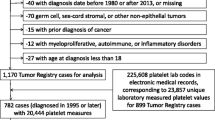Abstract
Background
Thrombocytosis has been reported in a variety of solid tumors, including certain gynecologic cancers such as endometrial, vulvar, and cervical cancers. The present study aims to determine the incidence of thrombocytosis in women with epithelial ovarian tumors and to evaluate its association with clinical and pathologic prognostic factors.
Material and methods
Between January 2001 and December 2006, 292 patients were diagnosed with epithelial ovarian tumors, and they underwent primary surgical treatment and subsequent platinum-based chemotherapy at the Gynecologic Oncology Department of the study center. The medical records of these patients were evaluated retrospectively.
Results
Of the 292 women with epithelial ovarian tumors undergoing primary surgical exploration, 124 (42.5%) had thrombocytosis, indicating platelet counts >400 × 109/l. Patients with thrombocytosis were found to have statistically higher levels of preoperative CA-125 levels, more advanced stage disease, higher grade tumors, and shorter periods of survival. Thrombocytosis is a significant negative prognostic factor for survival in patients with epithelial ovarian tumors.
Conclusions
Thrombocytosis is frequently detected in preoperative evaluation of women diagnosed with epithelial ovarian tumors. The data obtained by the previous and present studies suggest that thrombocytosis is associated with factors reflecting a more aggressive tumor biology, and predicting poor survival in women with epithelial ovarian tumors. However, these data are limited by the retrospective nature of the studies and do not confirm a casual relationship between thrombocytosis and tumor behavior. Molecular studies investigating the expression of platelet secretory factors are required to clarify the differences among data provided by the literature.

Similar content being viewed by others
Change history
18 August 2017
An erratum to this article has been published.
References
Amoletti JP, Albo D, Granick MS, Solomon MP, Castiglioni A, Rothman VL et al (1995) Thrombospondin and transforming growth factor-beta 1 increase expression of urokinase-type plasminogen activator and plasminogen activator inhibitor-1 in human MDA-MB-231 breast cancer cells. Cancer 76:998–1005
Benoy I, Salgado R, Colpaert C, Weytjens R (2002) Serum interleukin 6, plasma VEGF, serum VEGF, and VEGF platelet load in breast cancer patients. Clin Breast Cancer 2:311–315
Chalas E, Welshinger M, Engellener W, Chumas J, Barbieri R, Mann WJ (1992) The clinical significance of thrombocytosis in women presenting with a pelvic mass. Am J Obstet Gynecol 166:974–977
Constantini V, Zacharski LR, Moritz TE, Edwards RL (1990) The platelet count in carcinoma of the lung and colon. Thromb Haemost 64:501–505
Dabrow MB, Francesco MR, McBrearty FX, Caradonna S (1998) The effect of platelet-derived growth factor and receptor on normal and neoplastic human ovarian surface epithelium. Gynecol Oncol 71:29–37
Friebe Z, Watrowski R, Bembnista M, Rokowska A, Wlosiinska J (2005) Correlation between platelet count and CA–125 in ovarian cancer. Ginekol Pol 76(3):187–194
Gastl G, Plante M, Finstad CL, Wong GY, Federici MG, Bander NH et al (1993) High IL-6 levels in ascitic fluid correlate with reactive thrombocytosis in patients with epithelial ovarian cancer. Br J Haematol 83:433–441
Hefler L, Mayerhofer K, Leibman B, Obermair A, Reinthaller A, Kainz C et al (2000) Tumor anemia and thrombocytosis in patients with vulvar cancer. Tumour Biol 21:309–314
Hernandez E, Donohue KA, Anderson LL, Heller PB, Stehman FB (2000) The significance of thrombocytosis in patients with locally advanced cervical carcinoma: a Gynecologic Oncology Group study. Gynecol Oncol 78:137–142
Ikeda M, Furukawa H, Imamura H, Shimizu J, Ishida H (2002) Poor prognosis associated with thrombocytosis in patients with gastric cancer. Ann Surg Oncol 9:287–291
Kerpsack JT, Finan MA (2000) Thrombocytosis as a predictor of malignancy in women with a pelvic mass. J Reprod Med 45:929–932
Levin J, Conley CL (1964) Thrombocytosis associated with malignant disease. Arch Int Med 114:497–500
Li AJ, Madden CM, Cass I, Leuchter RS, Lagasse LD (2004) The prognostic significance of thrombocytosis in epithelial ovarian carcinoma. Gynecol Oncol 92:211–214
Menczer J, Schejter E, Geva D, Ginath S (1998) Ovarian carcinoma associated thrombocytosis: correlation with prognostic factors and with survival. Eur J Gynaecol Oncol 12:82–84
O’Keefe SC, Marshall FF, Issa MM, Harmon MP, Petros JA (2002) Thrombocytosis is associated with a significant increase in the cancer specific death rate after radical nephrectomy. J Urol 168:1378–1380
Pedersen LM, Milman N (2003) Diagnostic significance of platelet count and other blood analyses in patients with lung cancer. Oncol Rep 10:213–216
Qian X, Tuszynski GP (1996) Expression of thrombospondin-1 in cancer: a role in tumor progression. Proc Soc Exp Biol Med 212:199–207
Scholz HS, Petru E, Gucer F, Haas J (2000) Preoperative thrombocytosis is an independent prognostic factor in stage III and IV endometrial cancer. Anticancer Res 20:3983–3985
Schwarz RE, Keny H (2001) Preoperative platelet count predicts survival after resection of periampullary adenocarcinoma. Hepatogastroenterology 48:1493–1498
Soonthornthum T, Suraseraneewong V, Kengsakol K, Wijaithum K (2007) Thrombocytosis in advanced epithelial ovarian cancer. J Med Assoc Thai 90(8):1495–1500
Tamussino KF, Gucer F, Reich O, Moser F, Petru E (2001) Pretreatment hemoglobin, platelet count, and prognosis in endometrial carcinoma. Int J Gynecol Cancer 11:236–240
Zeimet AG, Marth C, Muller-Holzmer E, Daxenbichler G (1994) Significance of thrombocytosis in patients with epithelial ovarian cancer. Am J Obstet Gynecol 170:549–554
Author information
Authors and Affiliations
Corresponding author
Additional information
An erratum to this article is available at https://doi.org/10.1007/s00404-017-4483-9.
Rights and permissions
About this article
Cite this article
Gungor, T., Kanat-Pektas, M., Sucak, A. et al. The role of thrombocytosis in prognostic evaluation of epithelial ovarian tumors. Arch Gynecol Obstet 279, 53–56 (2009). https://doi.org/10.1007/s00404-008-0673-9
Received:
Accepted:
Published:
Issue Date:
DOI: https://doi.org/10.1007/s00404-008-0673-9




